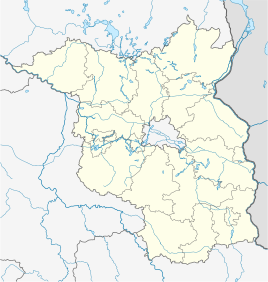Goßmar (Heideblick)
|
Goßmar
Municipality Heideblick
Coordinates: 51 ° 49 ′ 8 ″ N , 13 ° 41 ′ 51 ″ E
|
||
|---|---|---|
| Height : | 62 m above sea level NHN | |
| Residents : | 349 (Dec. 31, 2018) | |
| Incorporation : | December 31, 2001 | |
| Postal code : | 15926 | |
| Area code : | 03544 | |
|
Location of Goßmar in Brandenburg |
||
Goßmar ( Lower Sorbian Gósmar ) is a district of the municipality Heideblick in the district of Dahme-Spreewald , ( Brandenburg ). The village is located in the Niederlausitzer Landücken nature park .
history
Goßmar was founded around 1200. The name comes from Godomar , the god-famous. Goßmar was first mentioned in a document in 1368. The old farm properties on Dorfstrasse gave the village the shape of a rectangle.
The church, the school, the syringe house and the community forge stood on the village meadow. A large pond was south of the place. The suburb was later settled by working-class families and farmers. In 1723 Goßmar had 44 fireplaces and in 1880 546 inhabitants. Only after 1874 did the farmers develop into stable larger businesses.
The stollen tasting was known between Christmas and New Year. The youth met in the locker.
The Stoll riding at Whitsun was a horse race. In festive clothing, the girls mostly in white, the village gathered for a procession with music, the riders, the girls in decorated floats and the onlookers. In the village inn the suburbanites celebrated with the servants Stolle riding and Spinteball and the inn Green Tree celebrated the big farmers.
Goßmar was supplied by a country mailman until a post office was set up in 1935.
Land reform took place in September 1945 . In 1955 the first agricultural production cooperative (LPG) was established. In 1960 Goßmar became a fully cooperative village. The merger of the Luckau and Freesdorf cooperatives in 1975 and the Bornsdorf, Drehna and Weißack cooperatives in 1976 with LPG Goßmar created a large socialist animal production company. A cooperative was formed in 1972, the Plant Production Department.
The swimming pool was built in 1962 and the central water pipes from 1967. In 1971 the school in Goßmar was closed.
In 1992 the Heideblick office was established. In 2001 Beesdau , Berstequell , Falkenberg, Goßmar, Heideblick and Pitschen-Pickel merged to form the new municipality of Heideblick. In 2003 the Heideblick office was dissolved and the Heideblick community became vacant.
church
The Protestant, late Gothic village church was built as the successor to an earlier mother church, probably at the beginning of the 15th century. The hall church made of field stones with a three-sided east end and a slightly drawn-in transverse rectangular west tower is located at the west end of the village. It was expanded in brick around 1500 and plastered. The south vestibule with the tail gable in the late Renaissance form was built in the 17th century.
The organ dates from the end of the 18th century and was probably made in Schröter's workshop in Sonnewalde . The three original bells of the church were cast in 1861 by Hadank & Sohn in Hoyerswerda . They were melted down during World War II and replaced by new products in 1956.
The timing of the wall painting in the interior of the church on the south wall, which shows two female saints , has not yet been precisely determined. However, it was probably made in the 15th century.
Attractions
In the list of monuments in Heideblick there are two monuments for Goßmar :
- the village church
- the drive-through barn (Goßmar 9)
Web links
swell
- ↑ Community and district directory. In: geobasis-bb.de. Land surveying and geographic base information Brandenburg, accessed on July 16, 2017 .
-
↑ Sorbian name: Gósmar (formerly Gossmar Kreis Luckau )
→ Arnošt Muka : Lower Sorbian names of towns and villages ; 1911–1928, Sorbian Institute.
→ Arnošt Muka: building blocks for local history of the Luckauer Kreis. District Committee, Luckau 1918. - ↑ a b c Kulturland Brandenburg: Goßmar. Yesterday. Today. Tomorrow. An architectural walk. 2006.
- ↑ Dr. Heinrich Berghaus: Land book of the Mark Brandenburg and the Margrafthum Nieder-Lausitz in the middle of the 19th century. Ed .: Adolph Müller. Brandenburg 1854.


